
The Ultimate Guide to Buying a Used Excavator

Tips for Buying a Used Excavator
The cost of excavators can be high, but buying a used excavator can help you save. However, when used earth-moving equipment is purchased without taking the appropriate precautions and performing the necessary examinations, it can prove costly. In the same way that you would not purchase a used car without a thorough inspection, you should not buy a used excavator without studying all aspects of the machine in order to ensure that the value is in line with its current state.
In this article, we will take a closer look at some of the features and functions of excavators. In fact, we recommend you examine them carefully before purchasing a used excavator.
Swing Radius: Check for Play/Movement
In order to ensure that the slew ring is working normally, one should check if there is any play or movement that is not part of its normal operation. In order to ensure that there is no play or abnormal movement with the hydraulic excavator housing after it is rotated, it must be tight and smooth. Examine all connection points, particularly those between the boom and bucket. Check the pins and bushings for looseness. The accuracy will be compromised if the connection points are loose. One of the most expensive parts to replace is the slew ring if damaged.
Reviewing the Condition of Exterior Excavators
Dents, cracks, and bends should be checked on the machine’s exterior. As parts (such as the boom and stick) are heavily used, they may become warped and bent over time. This often requires the replacement of damaged parts, which can be costly. If the stick or other elements of the machine are dented, this may indicate the machine was misused previously.
The development of cracks on a part indicates that it has degenerated or is being misused and that the part will need to be replaced soon to prevent a larger issue from developing.
Check for Leaks in the Excavator Hydraulics
The presence of hydraulic leaks can also be an indication of misuse or degeneration. Therefore, all hydraulic cylinders, hoses, and lines should be inspected carefully. There ought to be a thorough inspection of both the hydraulic pump compartment and the swing bearing and slew ring to ensure that there is no leakage. In the event that there is any leakage, it should be repaired prior to purchasing the machine.
An Inaccurate or Malfunctioning Hour Meter
In order to ensure that the machine has been logged with the proper number of hours, the hour meter should be checked and authenticated. It is always a good idea to check the control pedals if the system is not working properly, or if there is any reason to doubt the validity of the readout. It may be an indication that the reading may not be accurate if there is a high amount of wear on the pedals.
Examine the Bucket and Attachments for Signs of Wear and Tear
When bucket teeth wear excessively, it could indicate a reduction in digging efficiency and could mean that bucket replacement is necessary. In order to determine whether the bucket teeth are scalloped, look for worn-down, half-moon-shaped teeth. Despite these defects, the bucket will most likely continue to operate, but with reduced efficiency, and replacement may be necessary in the near future.
Replacement Parts/Maintenance
Ensure that the model of the excavator is researched so that there are parts readily available should any of them on the machine break down and render it inoperable. In the future, the manufacturer’s support and maintenance may be a necessity, so it is wise to determine this before purchasing a model. Contact your local dealership to get a better understanding of their parts inventory for the model you are looking at purchasing.
Check the Undercarriage
Undercarriage is some of the most important and expensive parts of earth-moving equipment. The condition of the current undercarriage, if possible, should be examined to assess the amount and type of wear. It is important to realize that excavator undercarriage can have a wide-ranging lifespan based on the type installed and the application/terrain in which the excavator has been used. Wear patterns on different parts of your undercarriage can tell you a lot about how this machine was run and maintained by the previous owner.
Getting a Price Comparison
In general, excavators hold their value well. Although hours of use play a significant role in determining the value of new and used excavators, additional factors may also be considered, such as the model year, which attachments are included, and overall condition. Used Equipment is sold on many platforms, privately or through dealerships and auction houses. Make sure you are comparing apples to apples when price checking, and since used equipment will vary, make a list of aspects important to you and rate your options based on those aspects.
It’s a given that used equipment won’t be perfect. Every day, heavy equipment is put through harsh conditions and undergoes extreme tasks. The presence of cracks or bends in large sections of metal is never a good sign, particularly when they are at critical connection points or weld lines. A machine with cracks or dents could have been improperly maintained by its previous operator. This requires a close inspection of the mechanics to prevent premature failure.
Purchasing used equipment, however, can be a cost-effective way of expanding your fleet and growing your business. Just make sure you’re getting the most for your money.
See our used construction equipment sale page for currently available equipment or skip the search and let us do the research for you. To learn more, please call Nors Equipment at 1-888-492-4365 or contact us with any questions.



